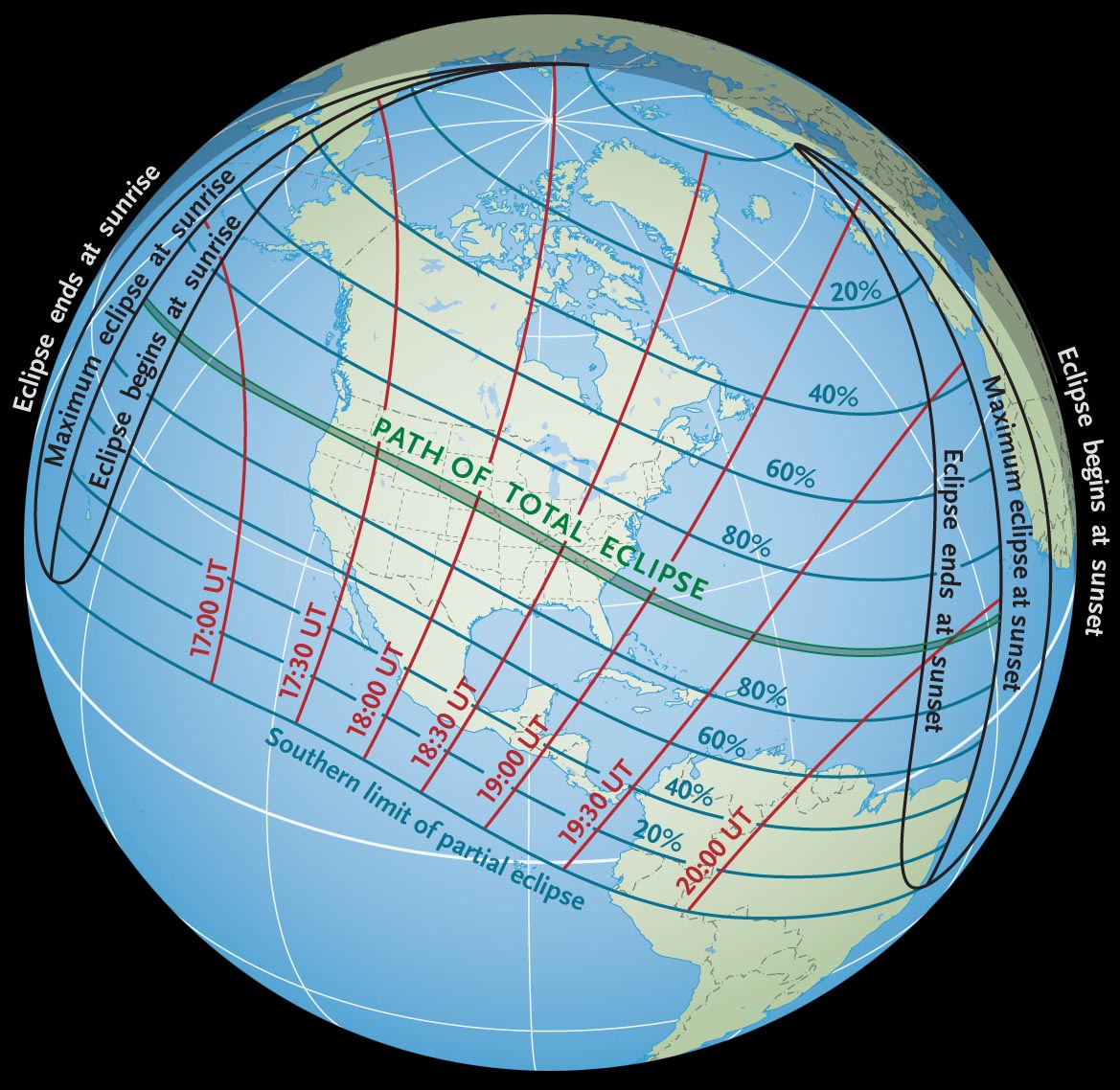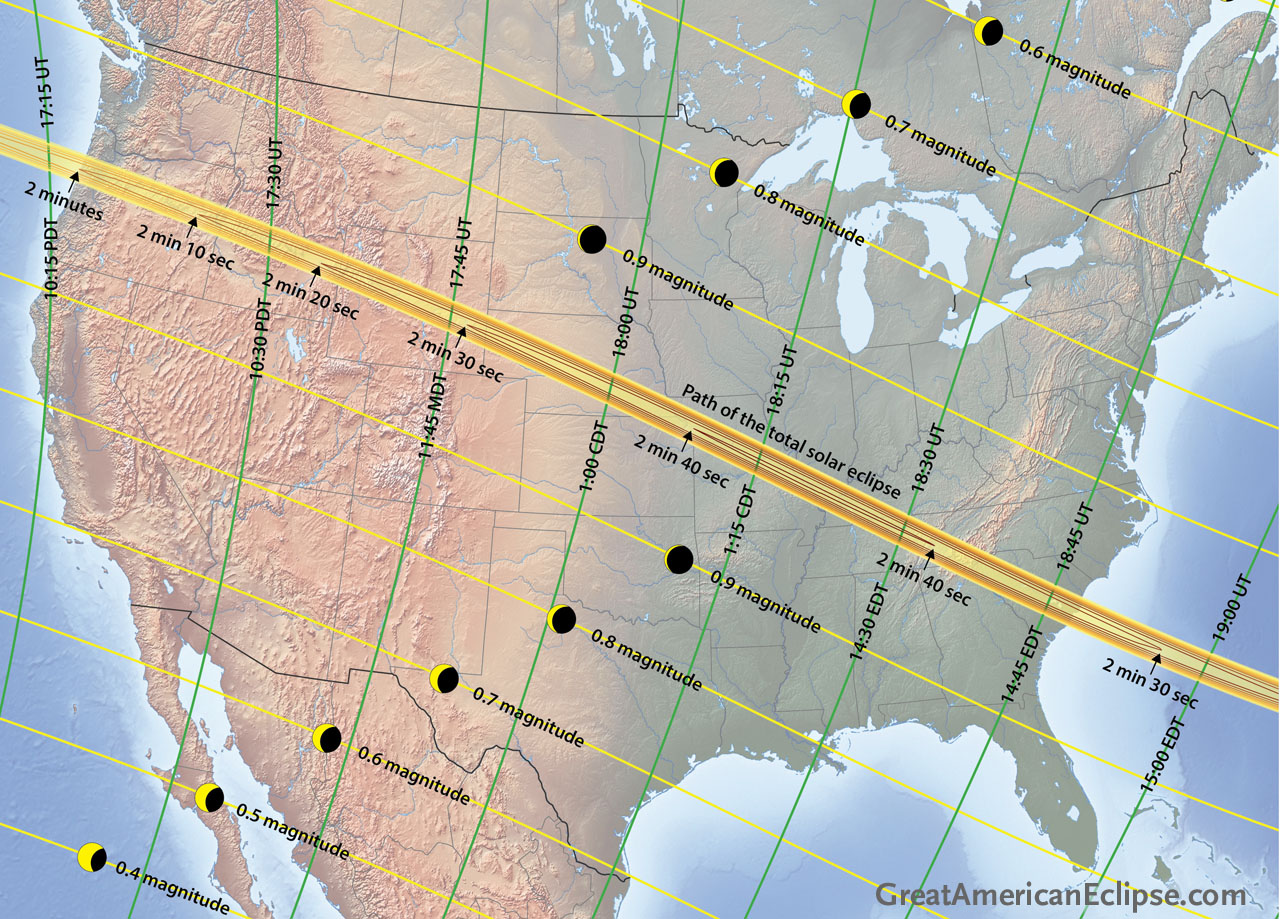Astronomy - 2017’s Total Solar Eclipse: One Year to Go!
It's still a full year away, but next year's coast-to-coast solar eclipse is already a big deal with astronomers worldwide.

The 8,600-mile-long path of 2017's total solar eclipse passes directly across the continental U.S. and offers up to 2.7 minutes of totality. Blue lines parallel to the dark track indicate the degree of partial eclipse to be seen elsewhere in the Americas. Red lines show Universal Times.
Sky & Telescope diagram / source: Fred Espenak
Sky & Telescope diagram / source: Fred Espenak
It's probably no surprise to you that we at Sky & Telescope are paying a lot of attention to the total solar eclipse that will race across the United States on August 21, 2017. That event is still a full year away, and yet the planning and preparation have already gotten seriously intense.
Of course, we're making sure that our magazine's readers are kept fully informed. Back in January, we published a definitive introduction to the eclipse's circumstances and weather prospects by the "dynamic duo" of eclipse chasing: Fred Espenak and Jay Anderson. On the following pages, astronomer Matt Penn (National Solar Observatory) outlined a novel eclipse-science effort called the Citizen Contenintal-America Telescopic Eclipse Experiment, or Citizen CATE, that seeks to place 60 teams of amateur astronomers along the centerline to image the inner corona's evolution during the 90 minutes that the Moon's shadow will be crossing the U.S.

Averaging about 68 miles wide, the path of the Moon's shadow on August 21, 2017, will cut through or clip 14 states during its 90-minutelong crossing from coast to coast. Everyone in North America outside this central path will see a partial solar eclipse that day.
Michael Zeiler / GreatAmericanEclipse.com
Michael Zeiler / GreatAmericanEclipse.com
Then, in August's issue, astro-historian William Sheehan took us back in time to the total solar eclipse of 1878, famous for the fact that astronomers headed to Wyoming to try to prove the existence of a small planet, Vulcan, purported to orbit very close to the Sun. Then San Diego amateur Donald Bruns explained how he's assembled the gear he'll need to measure the relativistic bending of starlight near the Sun and thus affirm Einstein's general theory of relativity. (He recently provided an update on his progress.)
But we're not nearly done in terms of informing you about next year's Big Event. More articles are planned for upcoming issues of Sky & Telescope, of course. And just this week we launched our new2017 eclipse portal on SkyandTelescope.com. You'll find lots of info, viewing tips, and how-to techniques there — and additional entries are coming soon, so check back often.
An Eclipse for Everyone
Few have witnessed a total solar eclipse, yet it is the most dramatic celestial event you'll ever see. During totality, with the Sun's brilliant disk fully covered, the sky turns dark (like very deep twilight) and the brightest planets and stars become visible. Animals become quiet, birds roost, and the temperature drops noticeably. There are so very many eclipse videos out there to show you what happens, but I particularly like the one recorded last March by the NASA/Exploratorium team. The narrators do an especially good job of describing all the phenomena that occur during totality.

Total solar eclipse over Easter Island, 2010. This composite records many delicate streamers in the Sun's corona.
Dennis di Cicco / Sky & Telescope
Dennis di Cicco / Sky & Telescope
But, honestly, no video or photograph comes close to capturing the excitement that you'll experience when you stand in the Moon's shadow and see the Sun's corona with your own eyes. And it's a totally immersive event: with the Sun's brilliant disk fully covered, the sky turns dark (like very deep twilight) and the brightest planets and stars become visible. Animals become quiet, birds roost, and the temperature drops noticeably.
I've always been amazed at the geometric coincidence that lets us witness this celestial spectacle. A total solar eclipse occurs when the Moon passes directly between the Sun and Earth. That's at the core of why it happens. Yet even though the Sun is 400 times larger than the Moon, it coincidentally lies about 400 times farther away. So, fortunately, the lunar disk is just large enough to cover the Sun entirely.
One of these occurs somewhere on Earth about every 18 months on average. But totality hasn't been observed from the continental United States since February 26, 1979. That was 37 years ago — and I think we're overdue for an encore! During next year's eclipse, the path of totality will be 8,600 miles long but only about 70 wide. Remarkably, although it starts in the Pacific and ends in the Atlantic, the Moon's shadow passes over land only in the U.S. The path crosses 14 states: Oregon, Idaho, Montana (barely), Wyoming, Nebraska, Iowa (barely), Kansas, Missouri, Illinois, Kentucky, Tennessee, North Carolina, Georgia, and South Carolina.
Next year the greatest duration, observable from a point 12 miles southeast of Carbondale, Illinois, will be 2 minutes 41.6 seconds (allowing for small adjustments caused by mountains and valleys along the Moon's limb. But anywhere along the centerline will provide at least 2 full minutes to ogle the Sun's corona.
Of course, the editors of Sky & Telescope are planning to see this spectacle firsthand too — so why don't you join us? We've planned two separate destinations for eclipse-goers: one in Glendo, Wyoming (which I described a few weeks ago) and the other near Hopkinsville, Kentucky.
An estimated 300 million people live within a 1- or 2-day drive of the eclipse track. In fact, more people might see next year's solar eclipse than any other in history. But that means accommodations within the path of totality are already hard to come by. Many hotels situated within the path were fully booked years in advance. So if you plan to travel to see the eclipse — and you really owe it to yourself to do so — you should be making plans now.
No comments:
Post a Comment